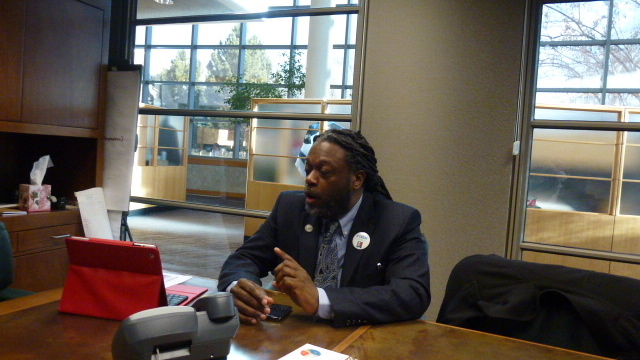
Rashid Davis didn’t know his school was going to get a mention in the State of the Union address.
The principal of Brooklyn, N.Y.’s Pathways in Technology Early College High School wasn’t even watching President Barack Obama’s speech. He was spending the evening of Feb. 12 working on a presentation when Obama hailed P-TECH. Then Davis’ phone began ringing, and it didn’t stop for several hours.
The first call came from Stanley Litow, a vice president with IBM and a partner in the 2-year-old P-TECH. The public-private collaboration offers high school students a ninth- to 14th-grade education — in hopes of providing the groundwork for an advanced college degree or the workplace.
For Davis, the State of the Union reference underscored the need to make sure America’s schools prepare all graduates for the future. “It sounded like a great acknowledgement, but it is a challenge,” Davis said in an interview Wednesday.
This week, that challenge took Davis to Boise, where he is meeting with business leaders interested in replicating the P-TECH model in Idaho.
The J.A. and Kathryn Albertson has offered $5 million in startup money for a charter school that, like P-TECH, would partner with private industry and a university. On Wednesday, the foundation met with prospective bidders. Letters of intent are due March 8, and final proposals are due April 5.
The idea behind the P-TECH partnership is to design a curriculum based on the job skills a company such as IBM needs, and based on the degree programs the university partner can provide. P-TECH offers two postsecondary focuses: computer information systems and electromechanical engineering technology. “We’re really just working backwards, from an H.R. perspective,” Davis said.
But that also requires rethinking the school day — and trying to make the best use of time.
When P-TECH opened in the fall of 2011, 43 percent of the school’s 104 ninth-graders were below grade level. The school added 80,000 instruction minutes that year, eschewing social studies and science courses for math and English — to give students better math and language skills for science courses down the road.
This fall, 103 students returned for their second year, and 62 are on a college track, Davis said.
P-TECH enrollment is open, and that’s not an accident. While company internships tend to go to the best and brightest students, America also needs more students in the STEM fields: science, technology, engineering and mathematics.
Some school officials are reluctant, Davis said. “As educators, we’re always skeptical. We’re skeptical until we see results.”
But Davis has gotten some traction in political circles. Iowa’s lieutenant governor came to Brooklyn for a P-TECH tour. A delegation from Oregon also came for a look. And on Tuesday, New York Gov. Andrew Cuomo said he would propose funding an additional 10 schools, in urban and rural areas statewide, employing the P-TECH model.
The P-TECH model can translate to rural New York state and rural Idaho, Davis said. Idaho’s work force issues are familiar — the need to better prepare graduates for high-tech jobs. And Idaho is in an enviable position, since it boasts one of the nation’s top high school graduation rates.
The question, though, is what a high school diploma means, and how that syncs with workplace realities. And that has long been an unresolved question in the education debate.
Said Davis, “It’s time we stop talking about it.”
Disclosure: The J.A. and Kathryn Albertson Foundation funds Idaho Education News.
